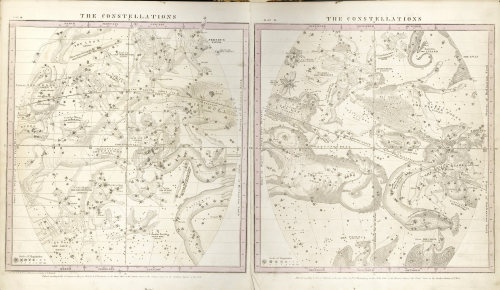Charting the 19th-century heavens – Astronomy Magazine
The stars and constellations of winter (left, Map III) and fall (Map II) are the first pair a student would encounter in Burritt’s Atlas. As in the sky, Orion the Hunter stands out on the winter map. Note that some regions of the figures, which should share the central borders of the maps, are missing.
All images: Library of Congress
Despite being relatively easy reads, the two publications carried impressive titles: The Geography of the Heavens, or Familiar Instructions for Finding the Visible Stars and Constellations; Accompanied by a Celestial Atlas, with a View of the Solar System, Illustrated by Engravings and Atlas Designed to Illustrate Burritt’s Geography of the Heavens. Each cost $1.25 in 1833, a bit pricey for the textbook, but a steal for the atlas.
The set was a smash hit. In the 16th edition, published in 1876, the preface stated that more than 300,000 copies had been sold. That number makes it the most popular star atlas of the 19th century. In fact, it wasn’t surpassed in sales until the mid-20th century, after numerous editions of Arthur Philip Norton’s Star Atlas and Reference Handbook, first published in 1910, had appeared.
Who was Burritt?
Elijah Hinsdale Burritt (his middle name was his mother’s maiden name) was born April 20, 1794, in New Britain, Connecticut. He was the first of 10 children.
When he was 18, Burritt ventured to a nearby town to study for two years to become a blacksmith. Unfortunately, he suffered an accident. That, along with motivation from his friends, caused him to enroll in Williams College in Williamstown, Massachusetts, where he studied astronomy, a subject he’d read a lot about during his recovery.
After a year, his finances forced him to take up a teaching job in 1817 to earn money to continue his studies. He then went back to college, but in 1819, he left to teach school (among other pursuits, including editing a weekly newspaper) in Milledgeville, Georgia. He remained there for 10 years before moving back to New Britain. While in Georgia, he married Ann Williams Watson, with whom he had five children.
Upon returning to Connecticut, he converted some property he owned, called the Stone Store, into a school. As part of the conversion, Burritt installed an observatory, featuring a telescope he had purchased, on the top floor.






